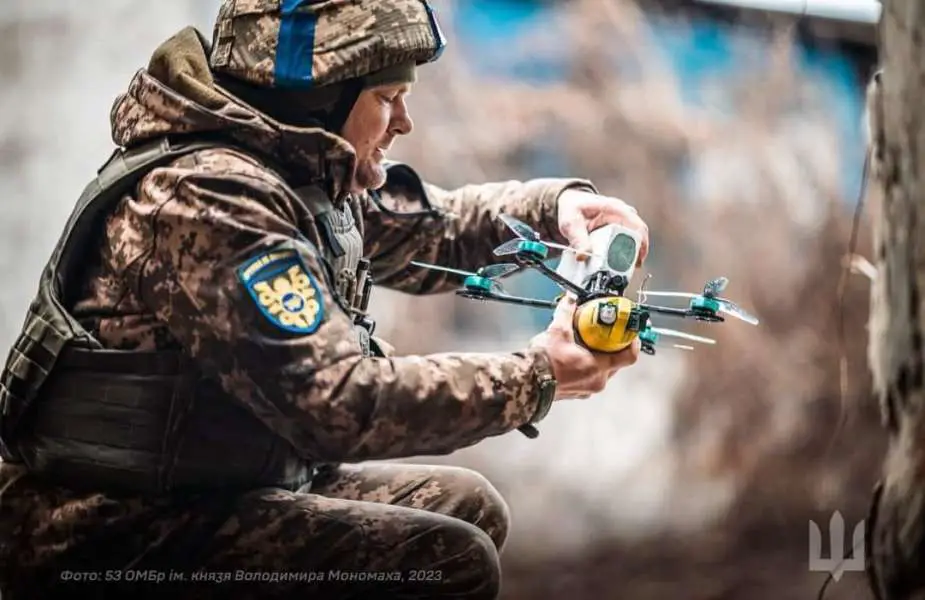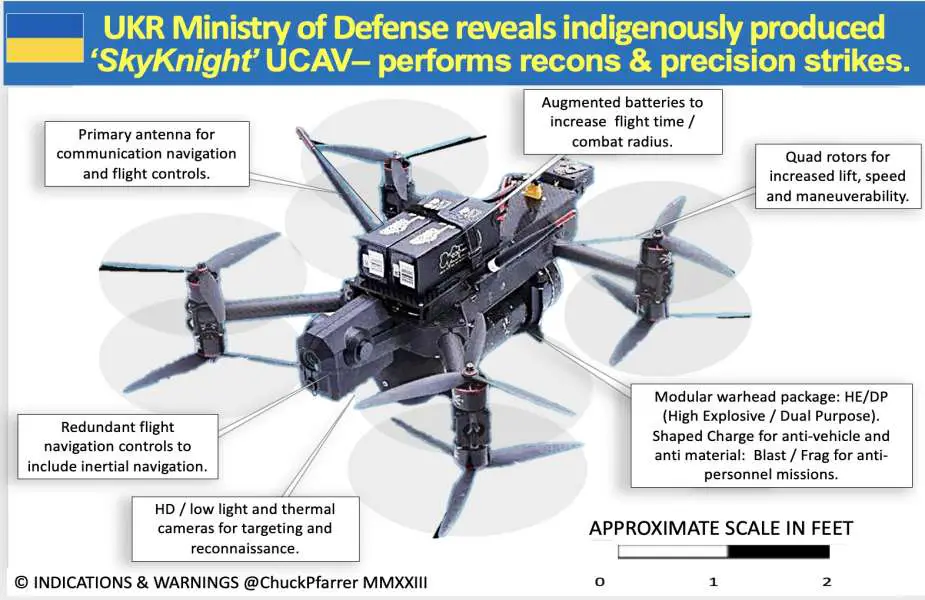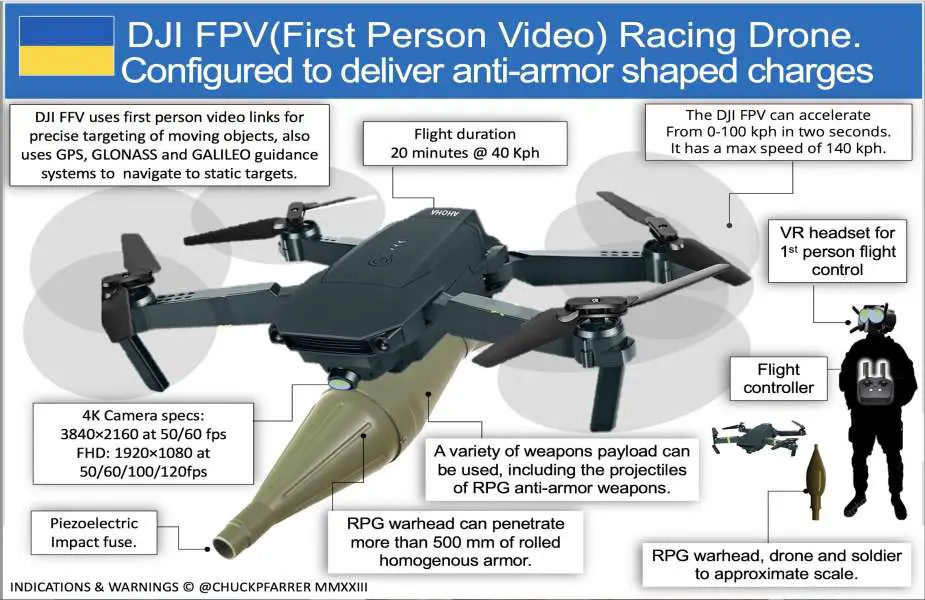In the ongoing Russo-Ukrainian conflict, Army Recognition continues its in-depth series on the military equipment used by Russian and Ukrainian forces. Following the inaugural episode focused on the Russian TOS-1A thermobaric rocket launcher—a symbol of the terrifying power and technological sophistication of modern warfare—the second episode delves into First-Person View (FPV) drone technology. Initially designed for entertainment and competition, this technology has been requisitioned for military operations, marking a significant evolution in battlefield reconnaissance and engagement. (Graphic picture of Drones from ChuckPfarrer X account)
Follow Army Recognition on Google News at this link

First-Person View drone system largely used in Ukraine (Picture source: Ukraine Army)
First-person view (FPV) refers to a method used to control drones or other remotely operated vehicles where the operator uses a live video feed from a camera mounted on the drone. FPV drones have revolutionized military tactics in the Russo-Ukrainian conflict, becoming a significant threat to traditional defense systems due to their unique capability for immersive surveillance and precise attacks. Originally adopted for drone racing and leisure, these devices offer pilots an unprecedented flying experience, where they can see in real-time through an onboard camera, simulating the impression of being inside the drone. This innovation allows for high-precision reconnaissance and surveillance, as well as the execution of targeted attacks with remarkable agility and discretion, thus challenging conventional approaches.
Since the Russian invasion of Ukraine on February 24, 2022, Ukraine has been at the forefront of employing FPV (First-Person View) drone technology to counter the Russian offensive cost-effectively while preserving human lives. Innovatively utilizing drones of various sizes, from compact models to those weighing over 454 kilograms, Ukraine has integrated both domestic innovations and international technologies, such as the Bayraktar TB2 from Turkey and commercially available FPV drones like the DJI Mavic and Phantom. This diverse fleet has played a crucial role in enhancing Ukraine's situational awareness on the battlefield, providing a significant advantage in monitoring, intelligence gathering, and executing precise strikes against Russian advances. The strategic deployment of these drones underscores a significant shift in modern warfare, leveraging advanced technologies to adapt to evolving conflict dynamics efficiently.
The early adoption by Ukrainians saw these drones equipped with a variety of specific equipment, including high-definition cameras for intelligence gathering and advanced transmission systems to extend their range. Adaptable dropping devices allowed for the transport and deployment of various payloads, from small explosive devices to electronic jamming equipment, enhancing the drones' effectiveness in offensive and surveillance roles. These capabilities have led to the destruction of countless Russian armored vehicles and air defense systems, which are much more expensive to build than the Ukrainian FPV drones. This technology, used on a large scale for the first time in the Ukrainian theater of operations, has since forced armies worldwide to adapt, with Ukraine managing to hold off the world's second-largest army, contrary to initial predictions.
The cameras mounted on FPV drones are designed to provide a broad view and are often adjustable to meet the specific needs of each mission. They play a crucial role in allowing detailed and real-time information gathering, essential for strategic decision-making on the battlefield. Furthermore, the ability of these drones to carry various payloads, from advanced surveillance equipment to small explosive devices, demonstrates their adaptability to a wide range of operational scenarios.
Image transmission is made possible through low-latency video transmission systems, ensuring a smooth and significant delay-free image flow to the pilot. This feature is vital for maintaining a high level of responsiveness during operations, where every second counts. These systems can operate on different frequencies to reduce interference, thus ensuring reliable communication even in hostile environments.
The modularity of FPV drones is another remarkable technical asset. Depending on the mission requirements, they can be equipped with different payloads, making these devices extremely flexible and effective for a variety of tasks. This ability to quickly adapt to changing needs is particularly valuable in military contexts, where conditions can rapidly evolve. In terms of deployment, FPV drones stand out for their portability and cost-effectiveness. Their relatively low cost and ease of deployment make them accessible to a wide range of users, from specialized military units to less equipped groups, allowing for the democratization of aerial reconnaissance and attack capabilities. The integration of OSD (On-Screen Display) features further enriches the piloting experience by providing real-time essential flight information, such as battery voltage, flight time, and altitude. This increased situational awareness is indispensable for operations where precision and efficiency are critical.
As the Russo-Ukrainian conflict evolved, both sides adapted their use of FPV drones to better meet the challenges posed by this new technology. On the Ukrainian side, the most significant innovation was the development of EFP-S (Explosively Formed Penetrator - Shock) armor-piercing munitions specifically designed for FPV drones. These lightweight munitions, capable of penetrating armored vehicles, marked a notable advance in Ukraine's offensive capabilities, allowing them to effectively target lightly armored enemy vehicles.
In response to the growing threat of these drones, besides launching its mass production of drones through reverse engineering, Russia developed a series of sophisticated countermeasures to neutralize this new form of aerial warfare. These efforts focused on two main areas: electronic warfare technologies and physical protection measures.
Russian forces have ramped up the use of portable electronic warfare systems designed to jam communication and navigation signals of FPV (First-Person View) drones. By disrupting the channels used for drone control as well as their satellite navigation systems (GPS, GLONASS, BeiDou, and Galileo), these devices aim to limit the operational effectiveness of enemy drones. Furthermore, Russia has innovated by equipping some of its FPV drones with hibernation devices, allowing them to remain inactive for weeks before being activated for an attack, showcasing innovation in both defensive and offensive uses of drones. The integration of FPV drones manufactured in China into the Russian arsenal has also been observed, enhancing its aerial surveillance and attack capabilities, and supplementing the local production of the Russian defense industry.

(Picture source: Our thanks to Chuck Pfaffer for the graphic contribution)
As illustrated in the graphic above, the Ukraine Ministry of Defense has introduced the 'SkyKnight,' an indigenously developed Unmanned Combat Aerial Vehicle (UCAV), which is a testament to the advancements in Ukraine's defense technology. This sophisticated UCAV is engineered for both reconnaissance missions and precision strikes, incorporating a primary antenna for essential functions such as communication, navigation, and flight controls. To ensure extended operational capability, its design includes augmented batteries for increased flight time and combat radius. The SkyKnight is equipped with quad rotors to enhance its lift, speed, and maneuverability, key attributes for maneuvering in challenging battlefield conditions. It also features redundant flight navigation controls, including inertial navigation systems, and is outfitted with high-definition, low-light, and thermal cameras for comprehensive targeting and reconnaissance tasks. The drone's versatility is further augmented by its modular warhead package, capable of carrying High Explosive/Dual Purpose (HE/DP) munitions, shaped charges for anti-vehicle and anti-material purposes, and Blast/Frag warheads for anti-personnel missions. This blend of features makes the 'SkyKnight' a formidable tool in modern warfare, offering a peek into the future of military engagements.
The DJI FPV, a racing drone illustrated in the graphic beyond, has been adapted for military use, capable of delivering anti-armor-shaped charges. Utilizing first-person video links, it achieves precise targeting of moving targets and employs GPS, GLONASS, and GALILEO for navigation towards stationary targets. This drone boasts a flight duration of 20 minutes at speeds of 40 Kph, with a remarkable acceleration from 0 to 100 Kph in just two seconds and a maximum speed of 140 Kph. It is controlled via a VR headset, ensuring immersive first-person flight control, and is equipped with a flight controller. The drone features a 4K camera capable of recording at various frame rates, enhancing its reconnaissance capabilities. Its versatility extends to carrying a range of weapon payloads, including RPG anti-armor projectiles, capable of penetrating over 500 mm of rolled homogeneous armor, demonstrating its formidable anti-armor capabilities. This sophisticated integration of technology makes the DJI FPV a versatile tool in modern warfare, bridging the gap between commercial technology and military application.

(Picture source: Our thanks to Chuck Pfaffer for the graphic contribution)















